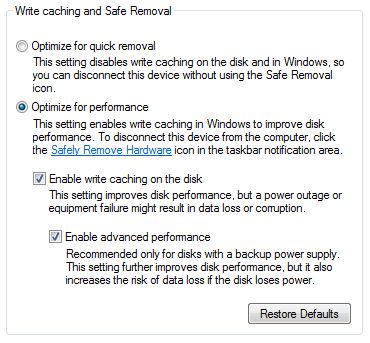Windows Vista operates external hard drives that are connected with USB differently than internal drives. Write caching is disabled so that you can safely remove the drive at almost any time. This is a great feature for USB thumb drives that are frequently inserted and removed from your computer. But if you have a large hard drive that is in an external enclosure that you never disconnect from your computer, write caching is also disabled which can decrease performance.
This tweak is going to show you how to increase the performance of your external hard drives by turning write caching back on as well as activating advanced performance. Let’s get started:
- Click on the start button, then right click on Computer and select Manage.
- Click on Device Manager on the side menu.
- Expand Disk drives and locate your external drive from the list.
- Right click on the drive and select Properties.
- On the Policies tab, select Optimize for performance.
- Next, check Enable write caching on the disk and Enable advanced performance as shown below.
 7. Hit OK and reboot.
7. Hit OK and reboot.
Enjoy the increased performance!

If you own a Google Chromecast streaming device, you can easily share a browser tab in Chrome browser or even your entire desktop. This can be very useful when presenting from your laptop or if you just want to watch something on a big screen that is only on your PC. The only requirement is you must be on the same network as your Chromecast...
Read More

If you are a fan of minimalist desktop experiences, hiding the desktop icons are an easy way to clean up the Windows interface. Instead of saving everything to your desktop, use the default profile folders such as downloads and documents. Actually hiding all the icons on your desktop is a very simple customization hidden in the right-click context menu. Just right-click on the desktop, select View...
Read More

Google security researchers have published details about a major security flaw found in the SSL protocol that is used to encrypt data transferred between your browser and a web server. SSL is typically used in situations where logon credentials are validated...
Read More

Enabling two-factor authentication is a great way to add an additional level of protection to your Microsoft account. Even if your password is stolen, your account is still protected because two-factor authetication requires an additional level of verification to log in. Microsoft calls their version of two-factor authentication "two-step verification" and it works by providing you with a random code...
Read More



